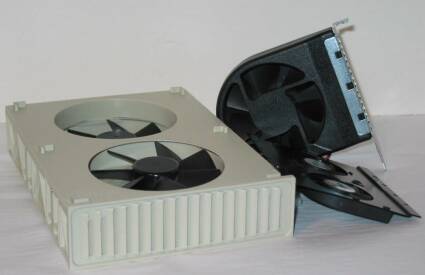How To Select The Right Case
The Sounds Of Silence - Air Flow & Fans, Continued
Of course, if you want to overclock and be quiet at the same time, liquid cooling continues to hold a lot of promise. Many people are now using these liquid cooling systems on a daily basis with no trouble at all. We took a look at liquid cooling in the article entitled, Water Coolers: Four Power Kits Starting at 200 Dollars , and this article showed that it is quite possible to use liquid cooling to also help reduce noise.
Cooling contraptions come in all shapes and sizes. In our opinion, the jury is still out on how much they really help or hurt the overall cooling strategy. Of course, for certain applications they might help a lot, but the disruption of air flow that they sometimes cause may just make it not worth it. More fans doesn't necessarily mean lower tempature.
When it comes to cooling, we have seen a lot of other contraptions that claim to help keep your case cool; these include items such as the slot blower, the dual bay fan and the drive fan. In many cases, use of these items will disrupt the intended air flow from the front of the case to the back of the case. This can defeat the cooling purpose by creating turbulence that does not allow a clear, efficient air flow from front to back. Can these contraptions help keep your case cool? Well, to be honest, it depends on the situation, but we suggest that you try all of the normal methods of cooling first before your get into these exotic solutions. This isn't to say that some of these more on-the-fringe methods of cooling are not useful, just that they can create problems with your air flow that are more difficult to troubleshoot without additional time and effort. And the case you choose will influence the effectiveness of these more exotic cooling methods, as well.
Although it isn't popular, we like to use some smoke in order examine the air flow in cases to determine of there is a cooling issue. One case fan that is pointed the wrong direction can cut your effective cooling, almost in half. Of course, if you happen to have plexiglass on the side of your case, this process is even easier, but you can get a general idea of the effectivness of your case's cooling potential just by feeding a little smoke through the front fan intake. Now, obviously smoke isn't good for any electronics, but it does help you get a better idea of how well your case's cooling solution is working and helps you locate those disruptive air flow problems.
Get Tom's Hardware's best news and in-depth reviews, straight to your inbox.
Current page: The Sounds Of Silence - Air Flow & Fans, Continued
Prev Page The Sounds Of Silence - Air Flow & Fans, Continued Next Page Case Layout Differences Can Leave You With Issues